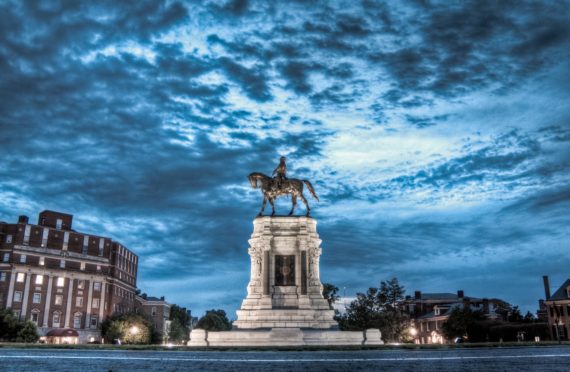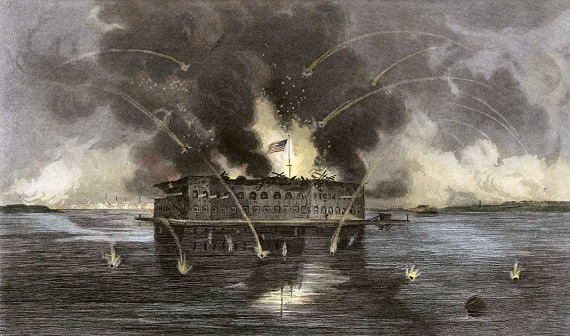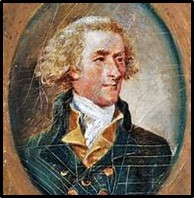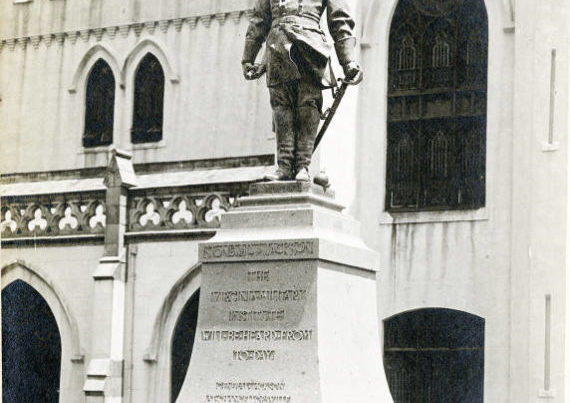Annie Gowan of The Washington Post writes of an incident a few years ago, June 2020, where a group of Portland, Oregon, protestors, gathered a high school and used bungee cords, wires, and human muscle to topple a statue of Thomas Jefferson off its pedestal and into the cement. Says 26-year-old removalist Triston Crowl, “When it came down, we could tell something had happened. This was a moment in history, at least in the city.” He then adds: “There should be a line at the Civil War. Every forefather prior to that should be considered a Confederate.” “There is no point in having these statues,” says 21-year-old Rosario Navalta, who was part of the activism. “All they do is remind everybody of the history of the United States and its role in perpetuating white supremacy and the institutionalization of anti-blackness.” She adds that Jefferson enslaved over 600 blacks in his life and had four children with teenager Sally Hemings.
Crowl and Navalta are illustrations of the rage of thousands of removalists, profoundly ignorant of U.S. history and taking it upon themselves to act on behalf of the citizenry as if they were suitable spokespersons to do that. As the discretionary comment of Crowl shows—“we could tell something had happened”—much of the removalist activity is by the hands of restive youths, who feel the need to be a part of something significant, and so when they are not texting, they desecrate or topple statues.
Something had happened. What precisely was that? I am sure that Crowl is unsure.
It is the same narrative, iterated and reiterated bromidically, and it is coupled with unsanctioned acts of vandalism that is tolerated by others only because any opposition to removalism is immediately taken as racism. It is just not a good time in our country to be white, and so the compunction-driven actions to remove our symbols of the past to forget our past.
Navalta’s claim that statues like that of Jefferson do nothing more than remind us of white supremacy and anti-blackness is profound in its naïveté—purest psittacism. We live in a time where everyone has something vital to say, but few are willing to listen. That was Plato’s criticism of pure democracy in Republic: Everyone thinks he is fit to be ruler over all others. When that is the case, the obvious result is chaos. Eschewal of potential chaos is why the Founders aimed to have elected representatives of the citizenry instead of a direct democracy in the manner of ancient Athens.
Yet perhaps we should follow Crowl’s insightful sentiment and draw a line “at the Civil War.” Every white “forefather” prior to the Civil War—were there Forefathers after the war?—can be taken as a racist and we can be open-minded about Whites thereafter, each perhaps to be examined on his own by a jury of removalists.
There are however some incommodious difficulties.
First, slavery was not confined to the South. There were slave owners in the North. Lincoln’s Emancipation Proclamation of January 1, 1863, applied only to the slaves in rebellious states. It allowed slaveholders in non-rebellious states to keep their slaves. It also gave Union soldiers the illusion that their cause, to preserve the Union, was really moral: to free those unfortunate Blacks in the Southern states. Yet that was a political maneuver, dressed up as a moral maneuver. There were many abolitionists in both the North and the South, yet very few were willing to go to war for the cause of freeing slaves. There never was and perhaps never will be a war fought wholly for a moral cause, though wars are always conveniently cloaked in “moral” verbiage to get soldiers to fight.
The Civil War was essentially about the South’s Constitutional right to secede, not about slavery. A good reason for secession was the economic burdens with which the North suffocated the South. That Lincoln sent 75,000 Union troops to keep the South from secession is inexplicable. The South had little option other than declaring war.
Second and pace Navalta, symbols, like the statue of Jefferson, mean different things to different persons. Human lives with the events in which they find themselves engaged are rich, complex tapestries. It is wrongheaded to see symbols of our American past only as representations of Southern slaveholding and as signs of hatred. Gen. Jubal Early’s monument near Fort Early in Lynchburg, Virginia, was erected because the general risked his life to defend the city against the rush of Union general David Hunter’s troops, advancing on the city in June 1864, much outnumbering his own, and pillaging and burning as he traveled. Early, who was at first a staunch Unionist, changed his mind when Virginia voted for secession in readiness for war with the North.
The adoption of that ordinance wrung from me bitter tears of grief; but I at once recognized my duty to abide the decision of my native state, and to defend her soil against invasion. … I recognized the right of resistance and revolution as exercised by our fathers in 1776 and without cavil as to the name by which it was called, I entered the military service of my State, willingly, cheerfully, and zealously.
Early was never shy of his belief in inferiority of Blacks. Yet the valor of Early and other generals forced Hunter, with superiority of numbers, to retreat after several skirmishes outside Lynchburg and saved the city.
Why did Early exhibit such valor? Early felt a deep duty to follow the decisions of his native state.
Would Crowl and Navalta put their life on the line to fight for racial justice? Toppling a statue as part of an irate mob is no large act of justice, and certainly no act of courage, though it is “a moment in history” and has earned Crowl quick celebrity on the internet—a celebrity that will be quickly lost in history. It was “a moment” in Lynchburg’s history when I took my dog last Sunday for a swim in James River—it was a real moment, as he had never been in the James River—though I doubt that future historians will find any need to record that event for posterity.
Moreover, the narrative of the good Northerners and the bad Southerners is enormously puerile, and it is frightening that it needs to be addressed. That is a consequence of the profound ignorance of removalists of their own history, from which they wish to extricate themselves. There were hateful and kind white slaveholders. There were black slave owners, many of whom too treated illy their slaves. There were also numerous thousands of white slaves.
Removalists are imposing willy-nilly a monolithic interpretation on symbols, as if the life of any one person, prior to the Civil War, can be reduced to one thing. As John Locke notes, no one has a right tell another how to think and what to think. Each has a right to freedom of conscience. I suggest that study of the intricacies of U.S. history and the dimensionality of U.S. historical figures might give removalists greater perspective so that if they do act, it will be thoughtful action. Action on ignorance is perilous. Yet many American youths are unacquainted with books, which are ever becoming cumbersome obsolescencies.
In the process of removing symbols of our country’s past, removalists are doing more to retard the cause of racial injustice than to advance it. They are aggravating many Americans who see more in the symbols than removalists see. The aggravation will continue to build, if removalists continue to act shortsightedly, and will have consequences that hopefully will not be sanguinary.
Finally, the moment is kairotic to recognize that our current racial problems cannot be solved by removing early symbols of our past. If one indescribably ignorant of Thomas Jefferson chooses to see the man as racist and lustful, then one is free to do that. Yet reading good, fact-founded history might conduce toward a change of mind, though good history, due to the “politesse” of political correctness, is hard to find, and reading for many today is agonizing.
Thus, I proffer the following tautology on which to ponder: Our history is our history. If some symbols are reminders that our history was not all glorious, then let that be. We are different than no other country in that. Should we raze the Coliseum in Rome because of the sanguinary gladiatorial games? Should we raze the Cathedral of Notre Dame because of the Crusades? Should we remove all symbols of Martin Luther King, Jr., because of his rampant womanizing?
If Navalta feels pain, it is her pain, caused by her guilt. The urgency to remove such symbols is, in psychoanalytic terms, displacement. The evil is in the markers and what they represent, so that once removed, the evil too is removed. Out of sight is out of mind. That is sophomoric reasoning. The racism is in us, in Whites and in Blacks (without recognition of black racists there can be no eradication of racism), and so this is a time for self-reflection and discussion, not displacement and forgetfulness.
The racism of our day—and I am not so convinced that it is as widespread as many make it out to be, as Americans are faddish and inordinately fond of self-deprecation—is our racism. It was not caused by Founding Fathers or by Confederates. It is just oversimple to inculpate them and exculpate ourselves. If any of us feel pain when looking at a statue of, say, Gen. Robert E. Lee, then we need look in the mirror and see what it is about ourselves by which we are discomfited.
Removalists like Crowl and Navalta cannot do that. Theirs is the language of segregation: They use “their past,” not “our past.” They are not part of America’s avowed racist past, because they are above racist sentiments. Hence, our American past could never be their past.
I do not feel the same pain when I see American symbols. When I see Gen. Early’s gravestone in Lynchburg, I am reminded of his belief in the inferiority of Blacks, but also of his intelligent crustiness—I like intelligent crustiness—and his unstinted bravery throughout the Civil War. When I drive down Martin Luther King Boulevard in Lynchburg, I am reminded of his salaciousness, but also of his large, powerful vision of racial equality and his courage to speak publically of it. I cannot assure anyone that the world would be a better place if Early had not been racist and King had not been salacious. They are parts of my past, and I willingly accept the symbols for what they remind me about what is good and what is bad about us as well as what is good and bad about me. Self-growth is, as Jean Piaget has shown, essentially a painful process.
Thomas Jefferson is known to have been fond architecturally of “building up and tearing down.” For him, that was part of a process of improvement and beautifying. We are today eager to tear down in order to forget, but we have no plan for building up. Again, we want to be heard, but are unwilling to listen.
Plato was not such a poor prophet!







Part and parcel of Jefferson’s notions of tearing down and rebuilding included the idea that, every generation or so, the Tree of Liberty needed to be watered with the blood of patriots and tyrants.
At least, there needed to be a convention of Constitutional revisionists to rethink the Constitution and make needed alterations, if any needed.
“There never was and perhaps never will be a war fought wholly for a moral cause, though wars are always conveniently cloaked in ‘moral’ verbiage to get soldiers to fight.”
And almost always the ones who promote the “moral cause” the loudest are the ones who seldom shoulder a rifle or fall in for duty.
Or who, when a son “wants to see something of the war,” arranges a spot on the commanding general’s staff? Where, according to that general’s most recent biographer, they had ice cream every night.
Absolutely! Race and the Civil War? Lincoln, as Wilson and others have shown, was window dressing.
Removalist. You sir need to learn words with real meaning, Like criminal, thug and thief. That’s what these people are. White supremacy. Some race or other will always be supreme, I vote for my race. The system I am forced to live in is an anti-God system, equality, God never made men equal, He created a culture of position, this is it Man is the head of woman, Christ is the Head of man and God is the head of Christ. These criminals you write about are in rebellion to God. This is why they hate Confederates because they were Godly men for the most part. This may come as a surprise to you sir, the White race is the race most associated with the worship of the Creator God. The white race took Christianity through the world. The current crop of criminals have the same nature as those people that attacked the South in 1861. This destruction of my history by criminal dogs is especially disgusting to me. I was a career soldier i served
with honor as so many other Southern men have. And you call those criminals removalist.
Kenneth:
My job as historian is not to politicize, but to describe in neutral terms situations. Bad actions will themselves incriminate the doers. It is for readers, not writers, to judge.
Kenneth Robbins,
Mark: How naive can I be. I believed that the job of historians was to tell the true story as closely as possible. Truth would be to call these people what they are, criminals. They are not removalist nor are they restive youth they are criminals. If someone burns a building what would he/she be? You have given these criminals cover with your terms. You call Jubal Early a racist. The term did not come into being until the communist of the Frankford School though it up in the 20th century, for the purpose of accusing their enemies. Lincoln also believed them inferior like most everyone else. MLK did not believe in the divinity of Christ, so much for him. Terms like racial justice or racial equality is pure humanism and rubbish. If you want justice You can find it with God.
Amen. It is a “Spiritual war.” One broken down to the least common denominator, it will be us vs., them or Christians vs., those who know no better. Poor souls.
M. Andrew Holowchak is as erudite as any out there.
Common sense and reasoned logic with a dose of understanding is something we need a lot more of.
Benn saying it for years been yelling at my TV News ….nobody is listening.
Accusations fly easily yet no one sits a moment to hear the concerns involved.
[““There is no point in having these statues,” says 21-year-old Rosario Navalta, who was part of the activism. “All they do is remind everybody of the history of the United States and its role in perpetuating white supremacy and the institutionalization of anti-blackness.””]
The major question is who be “everyone”? Not a person I know anywhere believes it an appropriate thing to defile with removal or destruction any of our Heritage-legacy statuary and cultural monuments. Talking to scholars overseas and here at home the response is the same leave the Artwork where it is we the public love our statues. Can we help it that 21- and 24-year-old gender and alternative social life studies majors think otherwise?
Another thing we artists whose careers oft depends on public/private sculptural commissions enjoy our work especially when culturally bereft and painfully ignorant rabble rousers do not attach their unnecessary “baggage” to it.
One other point Buggers the Heck out of me, in regard to hundreds of CSA statues that have unceremoniously been removed to score political capital…. why destroy monuments to American veterans and their families’ memories to their sacrifices, if these hundreds of thousands of war vets were around today this nonsense would be cut off at the bud……not taking sides because that would be puerile.